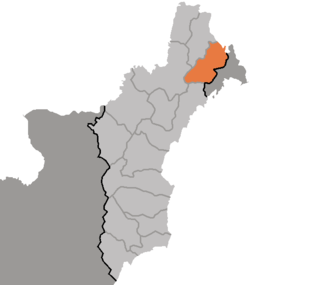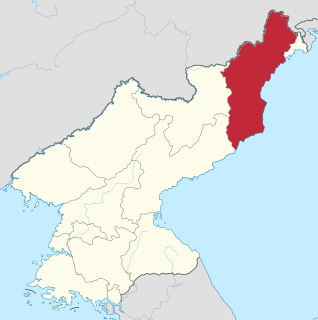Kot'o Station is a railway station in Hwangch'o-rodongjagu, Changjin County, South Hamgyŏng province, North Korea on the Changjin Line of the Korean State Railway. There is a spur from the station to a factory.
Kalli Station is a railway station in Hyongjesan-guyŏk, P'yŏngyang, North Korea. It is on located on the P'yŏngra and P'yŏngŭi lines of the Korean State Railway.
Hadan Station is a railway station in Chŏngju, North P'yŏngan Province, North Korea. It is on located on the P'yŏngŭi Line of the Korean State Railway.
Sŏp'yŏngyang Station is a railway station in Sŏsŏng-guyŏk, P'yŏngyang, North Korea. It is on located on the P'yŏngra and P'yŏngŭi lines of the Korean State Railway.
The Chosen Railway Company, was a privately owned railway company in Japanese-occupied Korea.
Sillyŏngri Station is a railway station in Sillyŏng-ri, Waudo-guyŏk, Namp'o Special City, North Korea on the P'yŏngnam Line of the Korean State Railway; it is also the northern end of the Sŏhae Kammun Line.
Tonggwangryang Station, or East Kwangryang Station is a railway station in Porim-rodongjagu, Onch'ŏn-gun, Namp'o Special City, North Korea on the P'yŏngnam Line of the Korean State Railway.
Sŏgwangryang Station, or West Kwangryang Station is a railway station in Kŭmgŏng-ri, Onch'ŏn county, Namp'o Special City, North Korea on the P'yŏngnam Line of the Korean State Railway.
Hwado Station is a railway station in Hwado-ri, Onch'ŏn county, Namp'o Special City, North Korea on the P'yŏngnam Line of the Korean State Railway.
Rosang Station is a railway station in Kwisǒng-rodongjagu, Onch'ŏn county, Namp'o Special City, North Korea on the P'yŏngnam Line of the Korean State Railway.
Ryongmun T'an'gwang Station is a railway station in Ryongmul-lodongjagu, Kujang county, North P'yŏngan province, North Korea. It is the terminus of the Ryongmun Colliery Line of the Korean State Railway.
The Sinhŭng Railway Company, was a privately owned railway company in Japanese-occupied Korea.
Sasu Station is a railway station in Yangji-rodongjagu, Changjin County, South Hamgyŏng province, North Korea, the northern terminus of the Changjin Line of the Korean State Railway.
Changyŏn Station is a railway station in Changyŏn-ŭp, Changyŏn County, South Hwanghae Province, North Korea. It is the terminus of the Changyŏn Line of the Korean State Railway.
Changbang Station is a railway station in Changbang-ri, Haeju City, South Hwanghae Province, North Korea, on the Hwanghae Ch'ŏngnyŏn Line of the Korean State Railway. It is also the western terminus of the Paech'ŏn Line.
The Dasado Railway, was a privately owned railway company in Japanese-occupied Korea.
The Pyeongbuk Railway was a privately owned railway company in Japanese-occupied Korea.
The Chosen Coal Industry Company was a kabushiki kaisha in colonial Korea that operated collieries in Aoji, Sinaoji and Obong in Gyeongheung County, North Hamgyeong Province. In addition to the mines, after the Chosen Synthetic Oil Company opened a large factory in Aoji-ri in 1937 to produce synthetic oil from the bituminous coal mined in the area, the Chosen Coal Industry Company built a railway line, called the Ao Line, to connect its mines to the chemical factory and to the South Manchuria Railway's North Chosen East Line, opening the line in two parts in 1938 and 1942.
The Chŏngdo Line is an electrified standard-gauge secondary line of the Korean State Railway in South Hwanghae Province, North Korea, running from Wangsin on the Ongjin Line to Chŏngdo.
The Chosen Pyeongan Railway, was a privately owned railway company in Japanese-occupied Korea.







